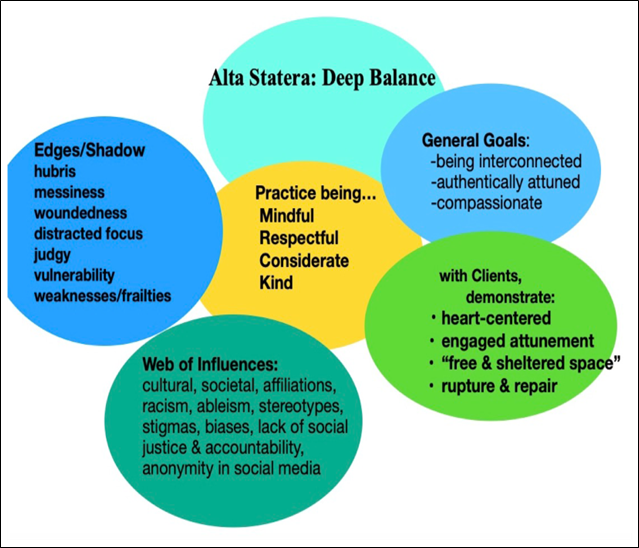
Alta Statera: Finding the Edges of Authenticity and Deep Balance in the Relationship with Play and Sand Therapy Clients
Rosalind L. Heiko
Dr. Roz Consulting & Training
Cary, North Carolina, USA
https://orcid.org/0000-0001-8844-7197
https://doi.org/10.58997/wjstp.v2i2.79
There are no known conflicts of interest to disclose.
Correspondence concerning this article should be addressed to Rosalind Heiko, Dr. Roz Consulting and Training, 531 Keisler Drive, Suite 203, Cary, NC 27518, United States. Email: rozheikophd@gmail.com
Abstract
This is the Conference Proceeding from Rosalind Heido entitled, Alta Statera: Finding the Edges of Authenticity and Deep Balance in the Relationship with Play and Sand Therapy Clients.
Alta statera means “deep balance” in Latin. Finding that depth of practice within the middle path means that we sand therapists work authentically and humbly with our clients and other professionals. It also means that we - at times - come to find the “edges” of that practice of unconditional positive regard in this sacred work with clients within the larger societal landscape. The minor irritations. The messiness, both literally and figuratively. The hurtful…the harmful…the shadow that shows up in client interchanges - as well as in other professional exchanges. We bring our own emotional states, thoughts, memories, and associations to the shared neural net of connection in sessions. We bring our biases, our prejudice, our racism and ableism, our patriarchal cultural values into our conversations, our homes, our workplaces. What do we need to be more aware of? How can we notice these dynamics? How then do we take all that in and respond with insight and compassion?
We are told that we sand therapists “should” be non-judgmental, “should” not let our attention wander, “should” manage our own emotions and reactions vigilantly so that we provide clients, in Sandplay founder and teacher Dora Kalff’s words, a “…free and protected/sheltered space.” These are lofty goals. How can we meet them with equanimity within the landscape of our cultural biases, our day-to-day pressures, the challenges of our hubris, and our shortcomings in our essential, fallible human nature within our social structure and in our therapy spaces?
Through partnering exercise and discussion, we examined our “edges” when getting in touch with our own vulnerability, the marginalized parts of ourselves [in how we ignore our own inflexibility, biases, prejudices, and feel ignored or devalued in our relationships, our languaging, and culture]. How can we better connect with sensing when we are close to rupture and figure out how to become more in resonance?
Dora Kalff articulated the phrase “coming to understand” in relation to the therapists in Sandplay needing to be observant and fluid. In their article on edge sensing in therapeutic exchanges, Glanzer and Early (2018) remark:
As therapist and client “bump up against” each other in moments of connection or in moments of awkwardness, the experience is noticed. Something alive happens when the moment is recognized in that encounter, so “something about that didn’t feel right to me”, or “boy, that …” creates or opens the space for something new. There is a bumping up against each other, which allows something to show up, to come to the here and now, and to be present together, in a way different from interpretation or analysis. It is not about the relationship as a “thing” but as the gift of being in and of enacting the relationship; it is not talking about the relationship but living in it. Mutual edge sensing embodies a living efficacy that works within this intersubjective matrix. The therapist knows she is standing on the dyadic stage filled with all of the tentativeness, energy, and messiness birthed in the improvisational moment.
This training addressed several Sand Competencies: 1). Skills: therapeutic presence; 2) Attitudes: trust/respect for the client and process, openness, humility, unconditional positive regard, and the powerful work of sand therapy. We began to explore the application of theory in exploring presence - and our edges - and to challenge ourselves to grow through committed focus and attunement. Developing this capacity for alta statera - the deep balance - of authenticity and edge sensing in our sand therapy spaces requires a commitment to cultivating self-care and meditation practices; attending to the present moment in sessions with regard to physical, sensory and emotional focused energy; and ongoing consultation and process work as well.
The accompanying Alta Statera Graphic (Figure 1) clarifies certain therapeutic goals and practice with regard to working authentically with clients. The graphic also illustrates some of the aspects in finding a balanced perspective when therapists come face to face with their own shadow [e.g., the messiness inherent when working with water and sand; therapist woundedness, distracted focus, vulnerability, judgmental attitudes and hubris].

References
Glanzer, D., & Early, A. (2018). The role of edge-sensing in experiential psychotherapy. The Journal of Psychotherapy, 66(4), 311-415. https://doi.org/10.1176/appi.psychotherapy.2012.66.4.391
Original content from this work may be used under the terms of the https://creativecommons.org/licenses/by-nc-nd/4.0/. Any further distributions of this work (noncommercial only) must maintain attribution to the author(s), the title of the work, journal citation, and DOI.
© World Association of Sand Therapy Professionals, World Journal for Sand Therapy Practice, Volume 2, Number 2, 2024